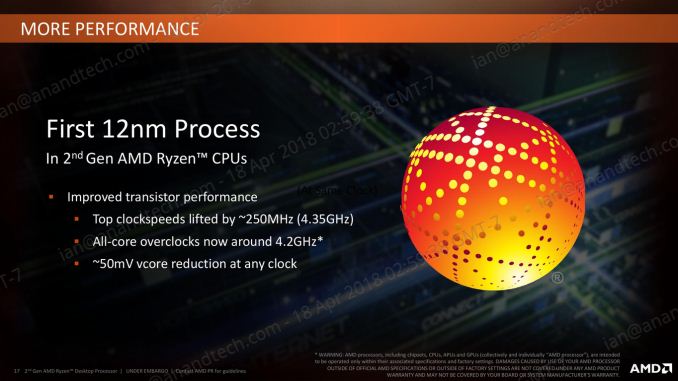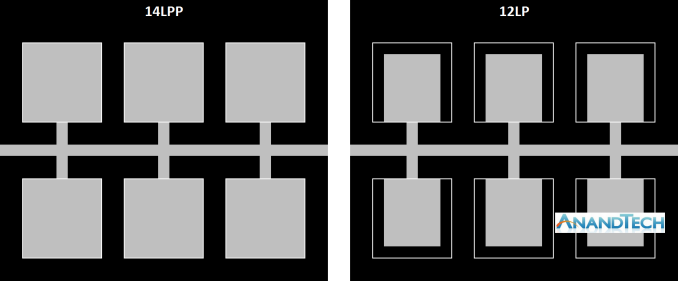The AMD 2nd Gen Ryzen Deep Dive: The 2700X, 2700, 2600X, and 2600 Tested
by Ian Cutress on April 19, 2018 9:00 AM ESTTalking 12nm and Zen+
One of the highlights of the Ryzen 2000-series launch is that these processors use GlobalFoundries’ 12LP manufacturing process, compared to the 14LPP process used for the first generation of Ryzen processors. Both AMD and GlobalFoundries have discussed the differences in the processes, however it is worth understanding that each company has different goals: AMD only needs to promote what helps its products, whereas GlobalFoundries is a semiconductor foundry with many clients and might promote ideal-scenario numbers. Earlier this year we were invited to GlobalFoundries Fab 8 in upstate New York to visit the clean room, and had a chance to interview Dr. Gary Patton, the CTO.
The Future of Silicon: An Exclusive Interview with Dr. Gary Patton, CTO of GlobalFoundries
In that interview, several interesting items came to light. First, that the CTO doesn’t necessarily have to care much about what certain processes are called: their customers know the performance of a given process regardless of the advertised ‘nm’ number based on the development tools given to them. Second, that 12LP is a series of minor tweaks to 14LPP, relating to performance bumps and improvements that come from a partial optical shrink and a slight change in manufacturing rules in the middle-line and back-end of the manufacturing process. In the past this might not have been so news worthy, however GF’s customers want to take advantage of the improved process.
Overall, GlobalFoundries has stated that its 12LP process offers a 10% performance improvement and a 15% circuit density improvement over 14LPP.
This has been interpreted in many ways, such as an extra 10% frequency at the same power, or lower power for the same frequency, and an opportunity to build smaller chips.
As part of today’s launch, AMD has clarified what the move to 12LP has meant for the Ryzen 2000-series:
- Top Clock Speeds lifted by ~250 MHz (~6%)
- All-core overclocks around 4.2 GHz
- ~50 mV core voltage reduction
AMD goes on to explain that at the same frequency, its new Ryzen 2000-series processors draw around 11% less power than the Ryzen 1000-series. The claims also state that this translates to +16% performance at the same power. These claims are a little muddled, as AMD has other new technologies in the 2000-series which will affect performance as well.
One interesting element is that although GF claims that there is a 15% density improvement, AMD is stating that these processors have the same die size and transistor count as the previous generation. Ultimately this seems in opposition to common sense – surely AMD would want to use smaller dies to get more chips per wafer?
Ultimately, the new processors are almost carbon copies of the old ones, both in terms of design and microarchitecture. AMD is calling the design of the cores as ‘Zen+’ to differentiate them to the previous generation ‘Zen’ design, and it mostly comes down to how the microarchitecture features are laid out on the silicon. When discussing with AMD, the best way to explain it is that some of the design of the key features has not moved – they just take up less area, leaving more dark silicon between other features.
Here is a very crude representation of features attached to a data path. On the left is the 14LPP design, and each of the six features has a specific size and connects to the bus. Between each of the features is the dark silicon – unused silicon that is either seen as useless, or can be used as a thermal buffer between high-energy parts. On the right is the representation of the 12LP design – each of the features have been reduced in size, putting more dark silicon between themselves (the white boxes show the original size of the feature). In this context, the number of transistors is the same, and the die size is the same. But if anything in the design was thermally limited by the close proximity of two features, there is now more distance between them such that they should interfere with each other less.
For reference, AMD lists the die-size of these new parts as 213mm2, containing 4.8 billion transistors, identical to the first generation silicon design. AMD confirmed that they are using 9T transistor libraries, also the same as the previous generation, although GlobalFoundries offers a 7.5T design as well.
So is Zen+ a New Microarchitecture, or Process Node Change?
Ultimately, nothing about most of the Zen+ physical design layout is new. Aside from the manufacturing process node change and likely minor adjustments, the rest of the adjustments are in firmware and support:
- Cache latency adjustments leading to +3% IPC
- Increased DRAM Frequency Support to DDR4-2933
- Better voltage/frequency curves, leading to +10% performance overall
- Better Boost Performance with Precision Boost 2
- Better Thermal Response with XFR2













545 Comments
View All Comments
mapesdhs - Saturday, April 21, 2018 - link
Not that that will stop the yelling and screaming. :)msroadkill612 - Thursday, April 19, 2018 - link
It's just hunch/intuition, but those cache improvements were outstanding, and apply to some seriously large chunks of cache. IMO, we haven't heard the last of perf improvements from this source, via driver tweaks etc.Tropicocity - Thursday, April 19, 2018 - link
My main gripe with people saying "other reviewers didn't use the meltdown/spectre" patches and stuff... 1. Those patches have already been tested and they do NOT affect gaming much at all, we're talking lower than 1%2. Even if you take out the entire meltdown/spectre thing, look at ryzen 1800x vs 2700x. a 3% IPC increase and some memory latency improvements do NOT account for 20% increased performance in gaming, not at a 200mhz clock change.
3. Even if Ryzen 2 series DID somehow gain 20% on Ryzen 1...why do other websites not show this? They all show at most 10%. Completely remove intel from the situation and you still have glaringly large performance jumps from Ryzen 1 to 2, this is what sticks out the most here.
ACE76 - Thursday, April 19, 2018 - link
You need to educate yourself on Meltdown/Spectre a bit more...patches are multilayered and in chipset driver, in the OS AND motherboard BIOS...unless the system being used isn't fully patched and using the latest BIOS and driver's, the test is useless.fallaha56 - Thursday, April 19, 2018 - link
Suggest you also look at the boost system on Ryzen (and also the power consumption)These higher scores are coming from much higher sustained multi core clocks...
Luckz - Monday, April 23, 2018 - link
If you look at page 8, this article shows 2018 Ryzen 2 versus Ryzen 1 performance from the dark ages. "Not retested for this article".BigDragon - Thursday, April 19, 2018 - link
I've been saying for months that Spectre and Meltdown will close the performance gap between Intel and AMD. All those speculative tricks will be reeled back in via security concerns. This article (and others like it) are confirming it.We shouldn't treat closing of the performance gap as a problem. This is not a black mark for Intel, and it's not a knockout punch from AMD. What this shows is that we have real competition in x86 again! Competition caused tremendous performance jumps in the AMD K7 and Intel Pentium days. Likewise, it's rapidly improved ARM offerings to make them a viable threat to x86. Competition is good!
Not sure that I'm ready to replace a 5-year old x79 i7-4930k system. The 2700X is very tempting, especially given that x79 lacks boot NVME support. I've been doing enough Blender and Unreal stuff that it may be a worthwhile speedup.
mapesdhs - Saturday, April 21, 2018 - link
Re NVMe boot, not true, it can be added to numerous mbds, especially ASUS (check the ROG thread with the modded BIOSs which one can install via FlashBack). Plus, you can use a 950 Pro or various other models since they already have their own boot ROM (ie. they don't need boot support on the mbd). I get over 3GB/sec with a 960 Pro on an ASUS R4E using a 4820K, 4930K and E5-2697 v2. Also have an SM961, various SM951 and some 950 Pros. Works great. I'm sure othe modders have done the same for non-ASUS boards.The modder on ROG has also made BIOS files for the M4E and P9X79/E WS on my request.
r13j13r13 - Thursday, April 19, 2018 - link
is incredible what AMD has achieved not only reached Intel but in many cases it exceeds above all in relation quality price that R5 2600X to 229 dollars for games looks greatchrcoluk - Thursday, April 19, 2018 - link
I really hope anandtech, didnt think it was realistic to bench a 8600k at 4.3ghz clocks? even really poor binned 8600ks hit 4.8ghz